Do Solid Waste Landfills Really Affect Land Use Change? Answers Using the Weighted Environmental Index (WEI)
Abstract
1. Introduction
2. Materials and Methods
2.1. The Information System on Land Occupation in Spain (SIOSE) Land Use Cartography
- PP: corresponds to the land use percentage if it is lower than 100%
- CC: corresponds to the land cover label
- aa1: corresponds to the first attribute
- aa2: corresponds to the second attribute
- aan: corresponds to the nth attribute
2.2. The Weighted Environmental Index (WEI)
- F1: Anthropic or natural nature of activity developed in soil.
- F2: Water consumption associated with land use.
- F3: Soil degradation (use of chemicals).
- F4: Environmental sustainability of land use (stability of the ecosystem).
- F5: Landscape value of activity carried out in the analyzed area.
2.3. WEI Computation Methodology
3. Case Study: The Solid Waste Landfills in Valencia Region (Spain)
3.1. Description of the Study Area
3.2. Results and Discussion
3.2.1. LCM and WEI Evolution over Time on the Landfill’s Influence Areas
- -
- In the Campello landfill area, 7.98% of forest association and 1.81% of grassland areas have been lost. Crop mosaics have increased by 9.08%, and the landfill with its treatment plant has been installed within an area equal to 0.61% of the total study area.
- -
- In the Caudete de las Fuentes landfill area, 0.5% of pasture areas have been lost. Urban zones have increased by 0.91% with respect to the total study area.
- -
- In the Cervera del Maestre landfill area, 0.64% of non-predefined mosaic areas have been lost. Urban zones have decreased by 0.21% with respect to the total study area. Mining zones and extraction zones have increased by 0.43%.
- -
- In the Dos Aguas landfill area, a reclassification in the SIOSE database may have been performed, as results show extreme LCM variations inside it.
- -
- In the Elche landfill area, 14.03% of forestry associations and 1.3% of fruit trees areas have been lost. Crop surfaces have increased by 10.29% and pastures by 2.97% with respect to the total study area.
- -
- In the Fontcalent landfill area, 2.75% of grassland and 2.18% of forest association areas have been lost. Crops have increased by 1.83% with respect to the total study area.
- -
- In the Onda landfill area, 12.63% of grassland, 2.18% of fruit-bearing areas, and 2.43% of the primary forests have been lost. Crops have increased by 15.40% with respect to the total study area.
- -
- In the Villena landfill area, 12.43% of the grassland and 2.98% of the vineyard areas have been lost. Crop areas have increased by 14.70%.
- -
- In the Xixona landfill area, 16.65% of the forest, 6.15% of grassland areas, and 2.21% of rainfed herbaceous crops have been lost. Crop mosaics have increased by 24.27% with respect to the total study area.
- The El Campello, Villena, and Elche landfills were built in 2005, so a decrease in the environmental value of the area was expected. Between 2009 and 2015, WEI values did not change significantly.
- The Onda, Xixona, and Fontcalent landfills were built in 2005, so a decrease in the environmental value of the area was expected. However, between 2009 and 2015, WEI values also decreased with time.
- The Algimia, Caudete de las Fuentes, and Cervera del Maestre landfills show a small decrease in the WEI values in the 2005–2009 period but a much larger decrease between 2009 and 2015. There is not enough information to explain these observations.
- The Dos Aguas landfill shows the largest WEI decrease (−10.59%), going from WEI = 73.31 in 2005 to WEI = 65.54 in 2015. As has been said above, an in-depth analysis has shown that this effect may be due to a reclassification in the SIOSE database, so it is not likely to be a direct effect induced by the landfill.
3.2.2. WEI Distribution Inside the Landfill Influence Area
4. Conclusions
- WEI is a powerful tool for analyzing land use change over time.
- The application of WEI allows performing detailed statistical analyses leading to key conclusions about land use changes inside the landfill influence areas
- WEI is therefore applicable as a tool to quantify and analyze trends of the environmental quality related to land use change.
- Results show that WEI has decreased in all the landfills in the 2005–2015 period.
- All the landfills are located in locations of high environmental value (WEI average value was over 70 during the whole period of analysis.
- The majority of the land use changes happened between 2009 and 2015. More than 8% of the area of WEI class [70,80[ and more than 4% of the area of WEI class [80,90[ were lost, and these areas are now occupied by a land use of lower value (almost 10% of the lost area is now included in WEI class [60,70[).
Supplementary Materials
Author Contributions
Funding
Data Availability Statement
Conflicts of Interest
References
- Castanho, R.A.; Gómez, J.M.N.; Kurowska-Pysz, J. Assessing land use changes in Polish Territories: Patterns, directions and socioeconomic impacts on territorial management. Sustainability 2019, 11, 1354. [Google Scholar] [CrossRef]
- Ansari, A.; Golabi, M.H. Prediction of spatial land use changes based on LCM in a GIS environment for Desert Wetlands—A case study: Meighan Wetland, Iran. Int. Soil Water Conserv. Res. 2019, 7, 64–70. [Google Scholar] [CrossRef]
- Leta, M.K.; Demissie, T.A.; Tränckner, J. Modeling and prediction of land use land cover change dynamics based on land change modeler (Lcm) in nashe watershed, upper blue nile basin, Ethiopia. Sustainability 2021, 13, 3740. [Google Scholar] [CrossRef]
- Sauve, G.; Van Acker, K. The environmental impacts of municipal solid waste landfills in Europe: A life cycle assessment of proper reference cases to support decision making. J. Environ. Manag. 2020, 261, 110216. [Google Scholar] [CrossRef] [PubMed]
- Anand, N.; Palani, S.G. A comprehensive investigation of toxicity and pollution potential of municipal solid waste landfill leachate. Sci. Total Environ. 2022, 838, 155891. [Google Scholar] [CrossRef]
- Ren, Y.; Zhang, Z.; Huang, M. A review on settlement models of municipal solid waste landfills. Waste Manag. 2022, 149, 79–95. [Google Scholar] [CrossRef]
- Koda, E.; Winkler, J.; Wowkonowicz, P.; Cerny, M.; Kiersnowska, A.; Pasternak, G.; Vaverková, M.D. Vegetation changes as indicators of landfill leachate seepage locations: Case study. Ecol. Eng. 2022, 174, 106448. [Google Scholar] [CrossRef]
- Calvo, F.; Moreno, B.; Ramos, A.; Zamorano, M. Implementation of a new environmental impact assessment for municipal waste landfills as tool for planning and decision-making process. Renew. Sustain. Energy Rev. 2007, 11, 98–115. [Google Scholar] [CrossRef]
- Yang, N.; Damgaard, A.; Lü, F.; Saho, L.M.; Brogaard, L.K.; He, P.J. Environmental impact assessment on the construction and operation of municipal solid waste sanitary landfills in developing countries: China case study. Waste Manag. 2014, 34, 929–937. [Google Scholar] [CrossRef]
- Ma, J.; Li, Y.; Li, Y. Effects of leachate recirculation quantity and aeration on leachate quality and municipal solid waste stabilization in semi-aerobic landfills. Environ. Technol. Innov. 2021, 21, 101353. [Google Scholar] [CrossRef]
- Kebede, Y.; Alene, M.M.; Endalemaw, N.T. Urban landfill investigation for managing the negative impact of solid waste on environment using geospatial technique. A case study of Assosa town, Ethiopia. Environ. Chall. 2021, 4, 100103. [Google Scholar] [CrossRef]
- Mohammad, A.; Singh, D.N.; Podlasek, A.; Osinki, P.; Koda, E. Leachate characteristics: Potential indicators for monitoring various phases of municipal solid waste decomposition in a bioreactor landfill. J. Environ. Manag. 2022, 309, 114683. [Google Scholar] [CrossRef] [PubMed]
- Wdowczyk, A.; Szymanska-Pulikowska, A. Analysis of the possibility of conducting a comprehensive assessment of landfill leachate contamination using physicochemical indicators and toxicity test. Ecotoxicol. Environ. Safe 2021, 221, 112434. [Google Scholar] [CrossRef]
- Shu, S.; Zhu, W.; Xu, H.; Wang, S.; Fan, X.; Wu, S.; Shi, J.; Song, J. Effect of the leachate head on the key pollutant indicator in a municipal solid waste landfill barrier system. J. Environ. Manag. 2019, 239, 262–270. [Google Scholar] [CrossRef] [PubMed]
- Ruoso, A.C.; Nora, M.D.; MairesseSiluk, J.C.; Duarte Ribeiro, J.L. The impact of landfill operation factors on improving biogas generation in Brazil. Renew. Sustain. Energy Rev. 2022, 154, 111868. [Google Scholar] [CrossRef]
- Curiel-Esparza, J.; Reyes-Medina, M.; Martín-Utrillas, M.; Martínez-García, M.P.; Cantó-Perelló, J. Collaborative elicitation to select a sustainable biogas desulfurization technique for landfills. J. Clean. Prod. 2019, 212, 1334–1344. [Google Scholar] [CrossRef]
- Mambeli Barros, R.; Tiago Filho, G.L.; da Silva, T.R. The electric energy potential of landfill biogas in Brazil. Energ. Policy 2014, 65, 150–164. [Google Scholar] [CrossRef]
- Nelson, A.C.; Genereux, J.; Genereux, M.M. Price Effects of Landfills on Different House Value Strata. J. Urban Plan. Dev. 1997, 123, 59–67. [Google Scholar] [CrossRef]
- Tey, J.S.; Goh, K.C.; Ang, P.S.E. Sustainable Impact of Landfill Siting towards Urban Planning in Malaysia. IOP Conf. Ser. Mater. Sci. Eng. 2015, 245, 052052. [Google Scholar] [CrossRef]
- Ready, R.C. Do Landfills Always Depress Nearby Property Values? J. Real Estate Res. 2010, 32, 321–340. [Google Scholar] [CrossRef]
- Gamble, H.B.; Downing, R.H.; Shortle, J.S.; Epp, D.J. Effects of Solid Waste Disposal Sites on Community Development and Residential Property Values. In Final Report for The Bureau of Solid Waste Management; Department of Environmental Resources, Commonwealth of Pennsylvania: Harrisburg, PA, USA, 1982. [Google Scholar]
- Bouvier, R.A.; Halstead, J.M.; Conway, K.S.; Manalo, A.B. The Effect of Landfills on Rural Residential Property Values: Some Empirical Analysis. J. Rel. Anal. Policy 2000, 30, 23–37. [Google Scholar] [CrossRef]
- Zeiss, C.; Atwater, J. Waste facility impacts on residential property values. J. Urban Plan. Dev. 1989, 115, 64–80. [Google Scholar] [CrossRef]
- Kotovicová, J.; Toman, F.; Vaverková, M.D.; Stejskal, B. Evaluation of waste landfills impact on the environmentwith the use of bioindicators. Pol. J. Environ. Stud. 2011, 20, 371–377. [Google Scholar]
- Vaverkovà, M.D.; Toman, F.; Adamcová, D.; Kotovicová, J. Verifying Research of Waste Landfill Environmental Impact Using Bioindicators. Pol. J. Environ. Stud. 2013, 22, 313–317. [Google Scholar]
- Eskandari, M.; Homaee, M.; Mahmoodi, S.; Pazira, E.; Van Genuchten, M.T. Optimizing landfill site selection by using land classification maps. Environ. Sci. Pollut. Res. 2015, 22, 7754–7765. [Google Scholar] [CrossRef] [PubMed]
- Rezaeisabzevar, Y.; Bazargan, A.; Zohourian, B. Landfill site selection using multi criteria decision making: Influential factors for comparing locations. J. Environ. Sci. 2020, 93, 170–184. [Google Scholar] [CrossRef]
- Eghtesadifard, M.; Afkhami, P.; Bazyar, A. An integrated approach to the selection of municipal solid waste landfills through GIS, K-Means and multi-criteria decision analysis. Environ. Res. 2020, 185, 109348. [Google Scholar] [CrossRef]
- Demesouka, O.E.; Anagnostopoulos, K.P.; Eleftherios, S. Spatial multicriteria decision support for robust land-use suitability: The case of landfill site selection in Northeastern Greece. Eur. J. Oper. Res. 2019, 272, 574–586. [Google Scholar] [CrossRef]
- De Feo, G.; De Gisi, S. Using MCDA and GIS for hazardous waste landfill siting considering land scarcity for waste disposal. Waste Manag. 2014, 34, 2225–2238. [Google Scholar] [CrossRef]
- Chabok, M.; Asakereh, A.; Bahrami, H.; Jaafarzadeh, N.O. Selection of MSW landfill site by fuzzy-AHP approach combined with GIS: Case study in Ahvaz, Iran. Environ. Monit. Assess. 2020, 192, 433. [Google Scholar] [CrossRef]
- Dolui, S.; Sarkar, S. Identifying potential landfill sites using multicriteria evaluation modeling and GIS techniques for Kharagpur city of West Bengal, India. Environ. Chall. 2021, 5, 100243. [Google Scholar] [CrossRef]
- Majid, M.; Mir, B.A. Landfill site selection using GIS based multi criteria evaluation technique. A case study of Srinagar city, India. Environ. Chall. 2021, 3, 100031. [Google Scholar] [CrossRef]
- Innocenti, F.; Robinson, R.; Gardiner, T.; Finlayson, A.; Connor, A. Differential Absorption Lidar (DIAL) Measurements of Landfill Methane Emissions. Remote Sens. 2017, 9, 953. [Google Scholar] [CrossRef]
- Torres, R.N.; Frternali, P. Learning to Identify Illegal Landfills through Scene Classification in Aerial Images. Remote Sens. 2021, 13, 4520. [Google Scholar] [CrossRef]
- Sliusar, N.; Filkin, T.; Humer-Humer, M.; Ritzkowski, M. Drone technology in municipal solid waste management and landfilling: A comprehensive review. Waste Manag. 2022, 139, 1–16. [Google Scholar] [CrossRef]
- Zamorano, M.; Molero, E.; Hurtado, A.; Grindlay, A.; Ramos, A. Evaluation of a municipal landfill site in Southern Spain with GIS-aided methodology. J. Hazard. Mater. 2008, 160, 473–481. [Google Scholar] [CrossRef]
- Mitri, G.; Nasrallah, G.; Gebrael, K.; Nassar, M.B.; Abou Dagher, M.; Nader, M.; Masri, N.; Choueiter, D. Assessing land degradation and identifying potential sustainable land management practices at the subnational level in Lebanon. Environ. Monit. Assess. 2019, 191, 1–22. [Google Scholar] [CrossRef]
- Feng, S.; Zhao, W.; Zhan, T.; Yan, Y.; Pereira, P. Land degradation neutrality: A review of progress and perspectives. Ecol. Indic. 2022, 144, 109530. [Google Scholar] [CrossRef]
- Benini, L.; Bandini, V.; Marazza, D.; Contin, A. Assessment of land use changes through an indicator-based approach: A case study from the Lamone river basin in Northern Italy. Ecol. Indic. 2010, 10, 4–14. [Google Scholar] [CrossRef]
- López, S.; López-Sandoval, M.F.; Gerique, A.; Salazar, J. Landscape change in Southern Ecuador: An indicator-based and multi-temporal evaluation of land use and land cover in a mixed-use protected area. Ecol. Indic. 2020, 115, 106357. [Google Scholar] [CrossRef]
- Bicudo da Silva, R.F.; Millington, J.D.A.; Moran, E.F.; Batistella, M.; Liu, J. Three decades of land-use and land-cover change in mountain regions of the Brazilian Atlantic Forest. Landsc. Urban Plan. 2020, 204, 103948. [Google Scholar] [CrossRef]
- Teucher, M.; Schmitt, C.B.; Wiese, A.; Apfelbeck, B.; Maghenda, M.; Pellikka, P.; Lens, L.; Habel, J.C. Behind the fog: Forest degradation despite logging bans in an East African cloud forest. Glob. Ecol. Conserv. 2020, 22, e01024. [Google Scholar] [CrossRef]
- Rawat, J.S.; Kumar, M. Monitoring land use/cover change using remote sensing and GIS techniques: A case study of Hawalbagh block, district Almora, Uttarakhand, India. Egypt. J. Remote Sens. Sp. Sci. 2015, 18, 77–84. [Google Scholar] [CrossRef]
- Rodrigo-Ilarri, J.; Romero-Hernández, C.P.; Rodrigo-Clavero, M.E. Land Use/Land Cover Assessment over Time Using a New Weighted Environmental Index (WEI) Based on an Object-Oriented Model and GIS Data. Sustainability 2020, 12, 10234. [Google Scholar] [CrossRef]
- European Comission. Corine Land Cover: Technical Guide; Directorate-General for Environment, Directorate-General for the Information Society and Media, Publications Office: Brussels, Belgium, 1994. [Google Scholar]
- Fernández Noguerol, S. Desarrollo de herramientas para el tratamiento de la información y el análisis con SIG de los usos del suelo utilizando el SIOSE. Una aproximación al caso de Asturias. GeoFocus Rev. Int. Cienc. Y Tecnol. La Inf. Geográfica 2017, 20, 233–251. [Google Scholar] [CrossRef][Green Version]
- Vila-García, D.; Gil-Docampo, M.L.; Iniesto-Alba, M.J. Change detection in land use from unsupervised classifications for updating SIOSE. Implementation in Galicia. Rev. Teledetección 2015, 43, 63–75. [Google Scholar] [CrossRef][Green Version]
- IGN. Descripción del modelo de datos SIOSE. 2015. Available online: www.siose.es (accessed on 1 June 2022).
- Carpintero, I.; Granado, L.; Méndez, E.; Montoya, G.; Pino, I.; Prieto, R.; Vales, J.; Giménez de Azcarate, F.; Moreira, J.M. Detección de Cambios en Zonas Forestales Para la Actualización de SIOSE-Andalucía 2005 a 2009 con Imágenes SPOT-5 (REDIAM); Proceedings of the XIV Congreso de la Asociación Española de Teledetección (AET): Mieres, Spain, 2011. [Google Scholar]
- Generalitat Valenciana. Plan Integral de Residuos de la Comunidad Valenciana, 2013. In DECRETO 81/2013, de 21 de Junio, del Consell, de Aprobación Definitiva del Plan Integral de Residuos de la Comunitat Valenciana (PIRCV); Generalitat Valenciana: Catalonia, Spain, 2013. [Google Scholar]
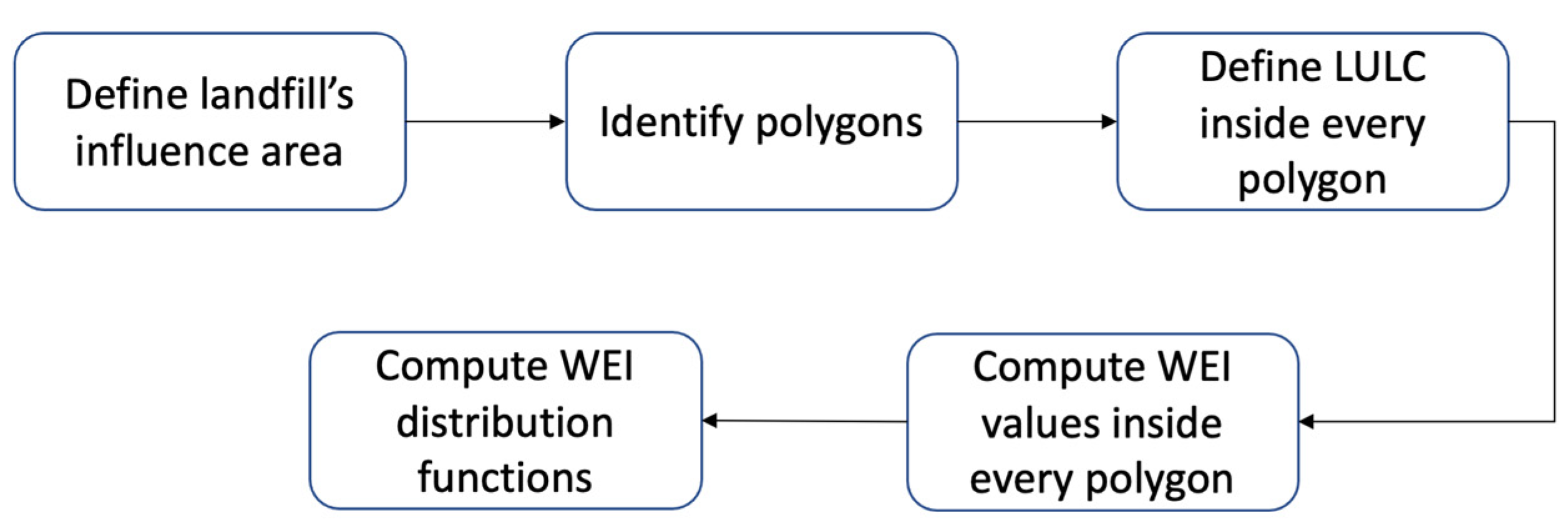
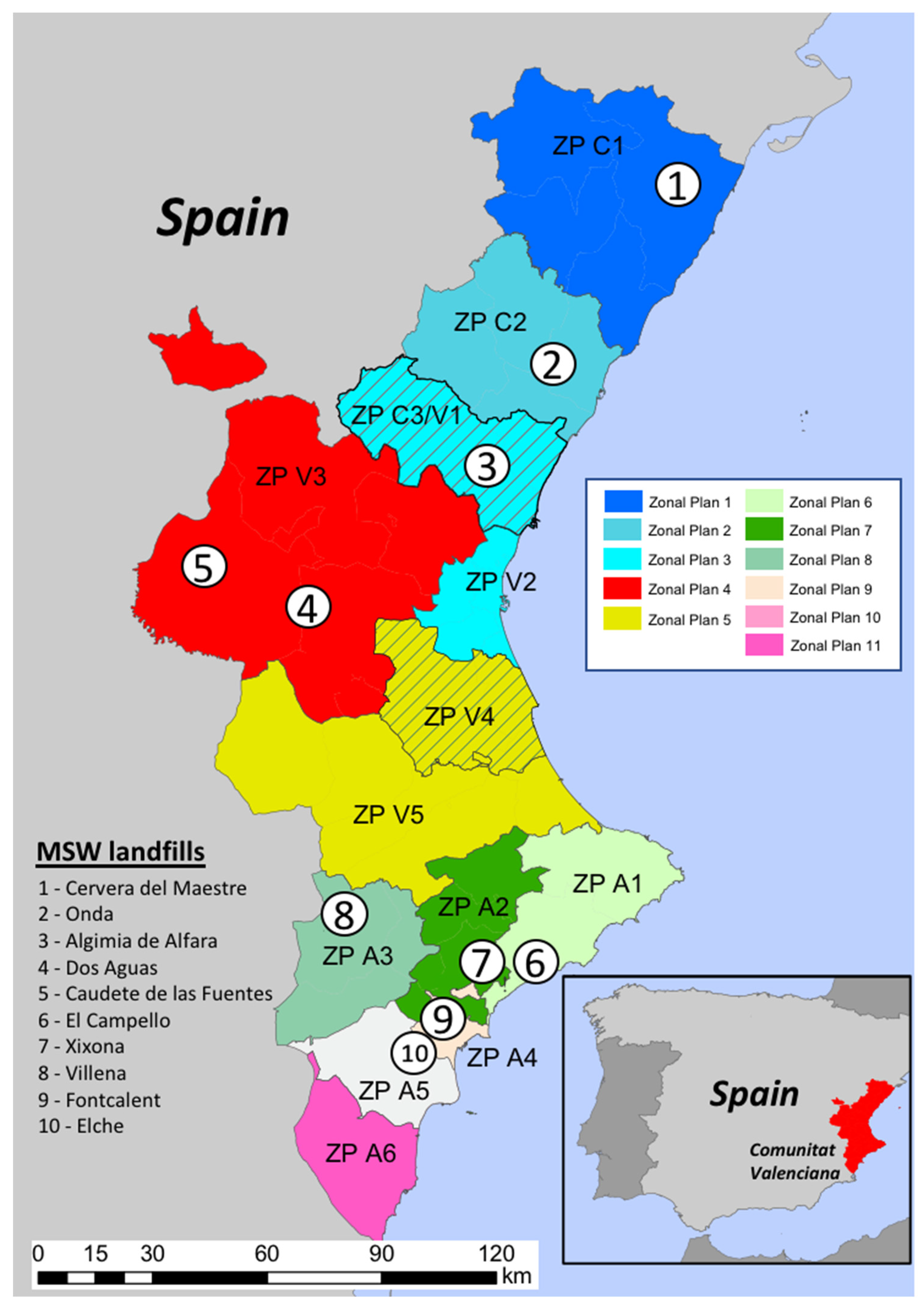

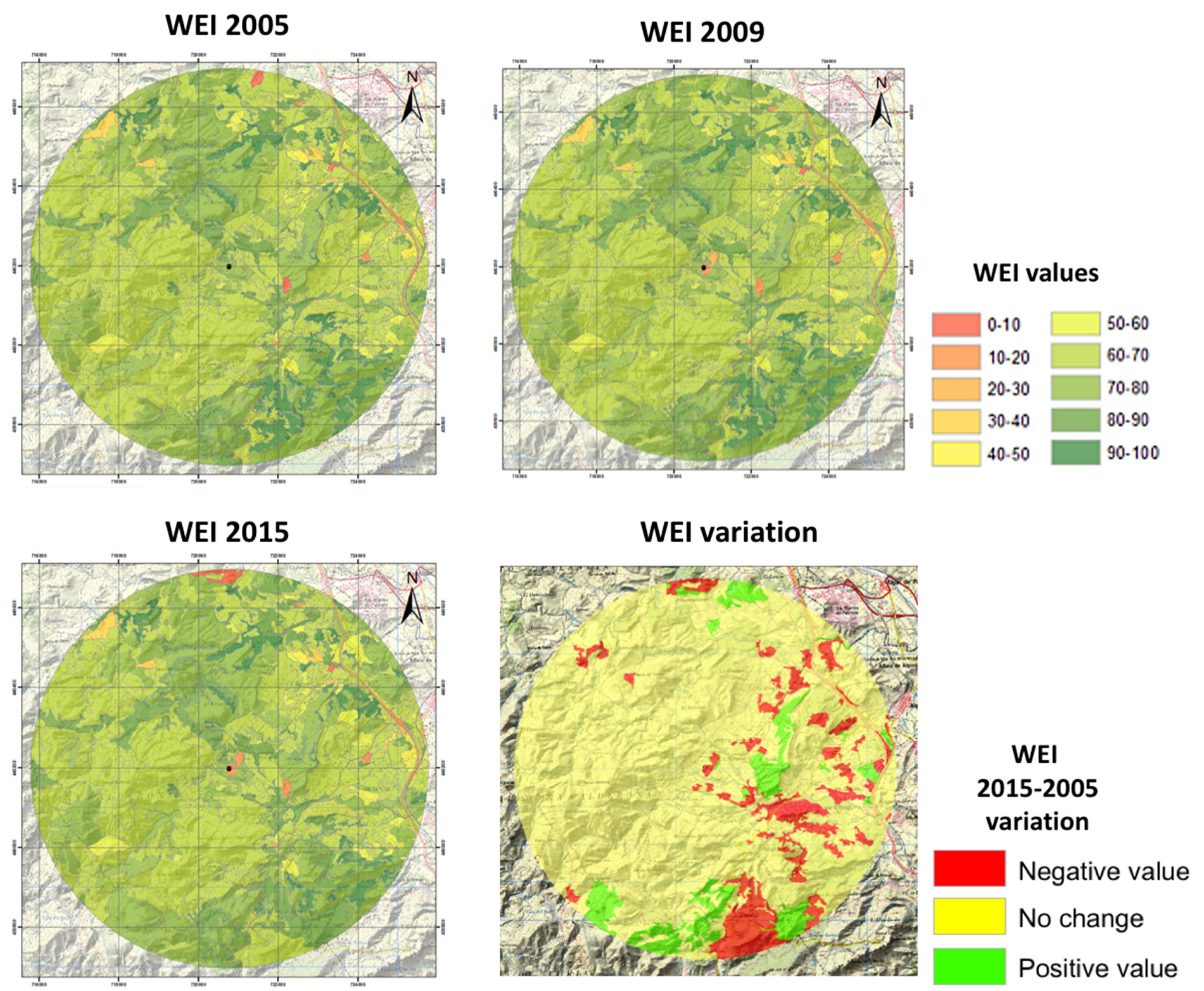
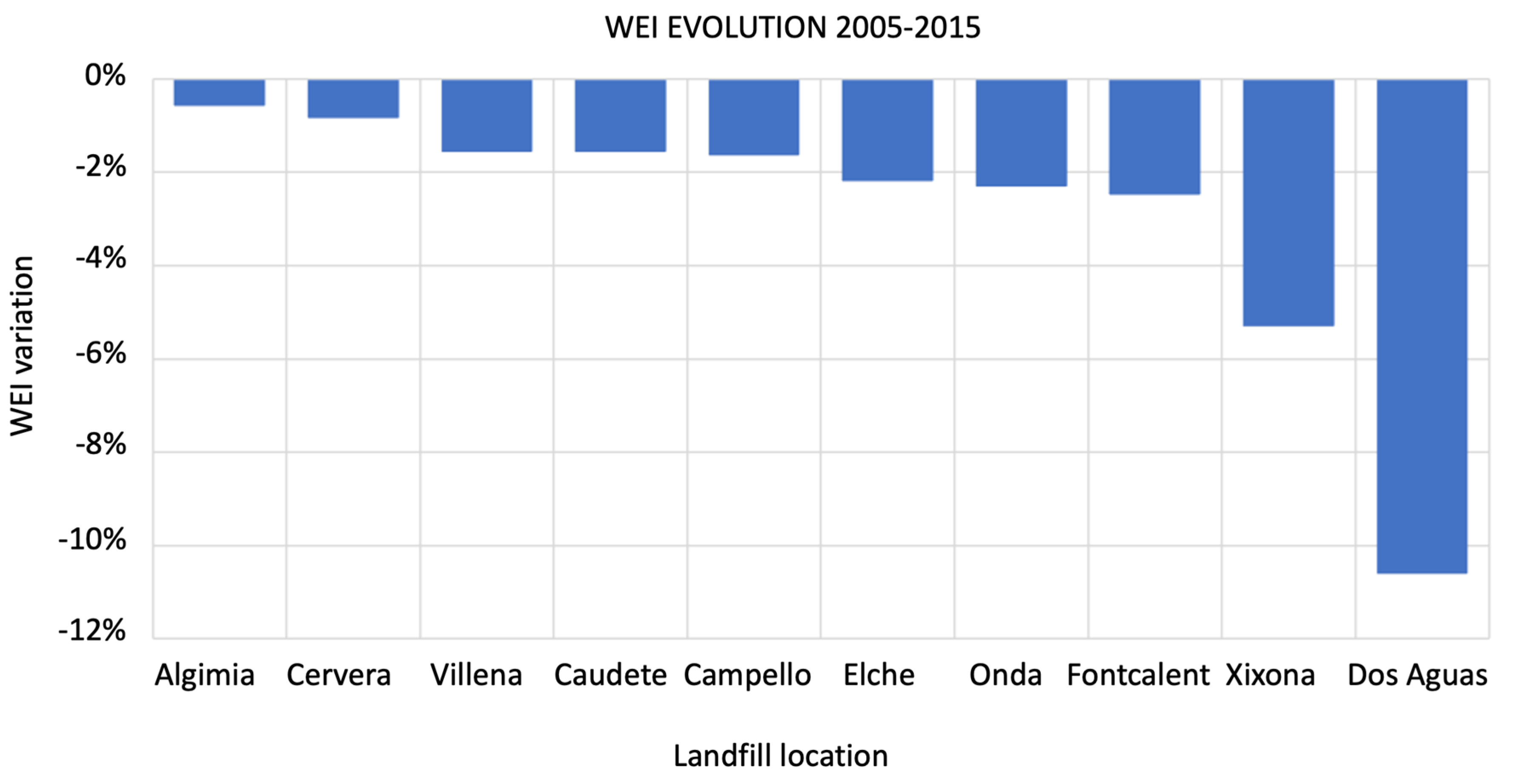
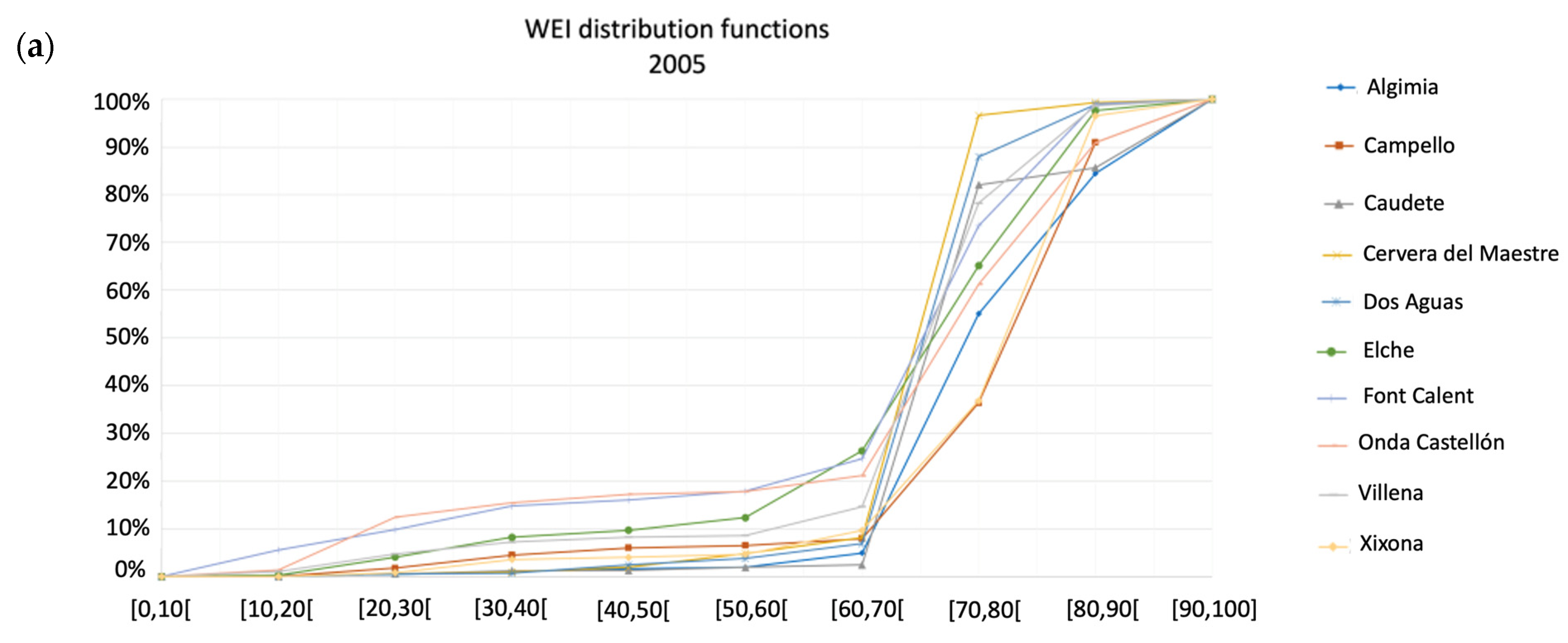
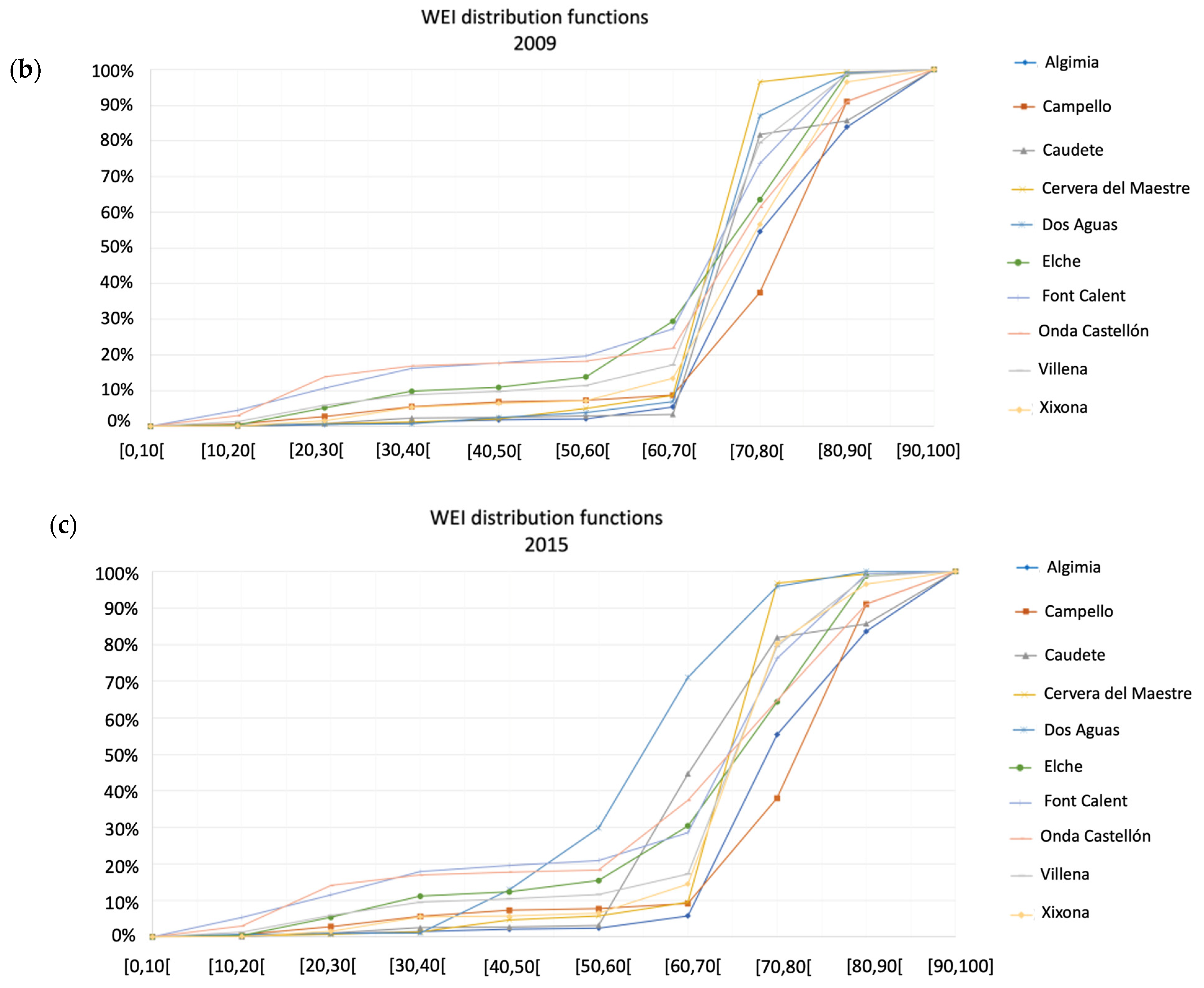
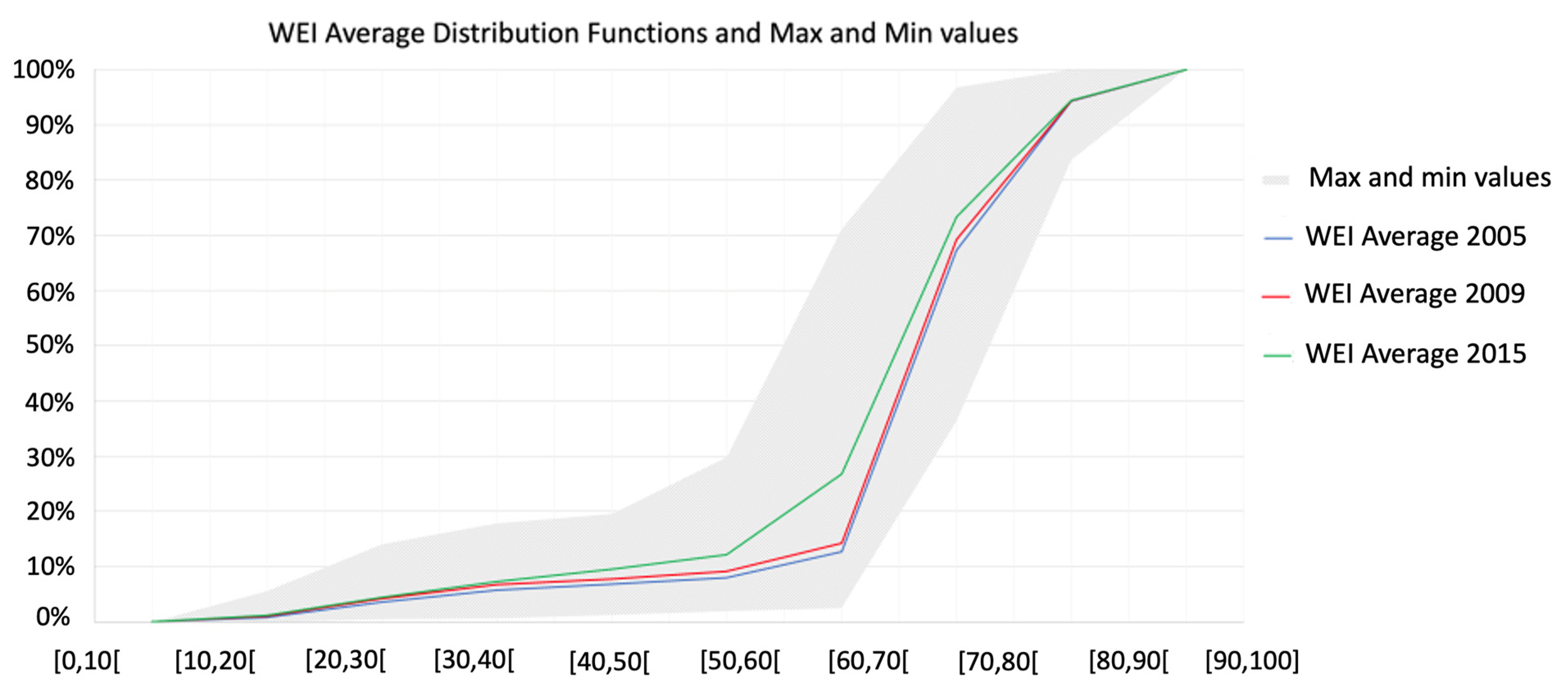
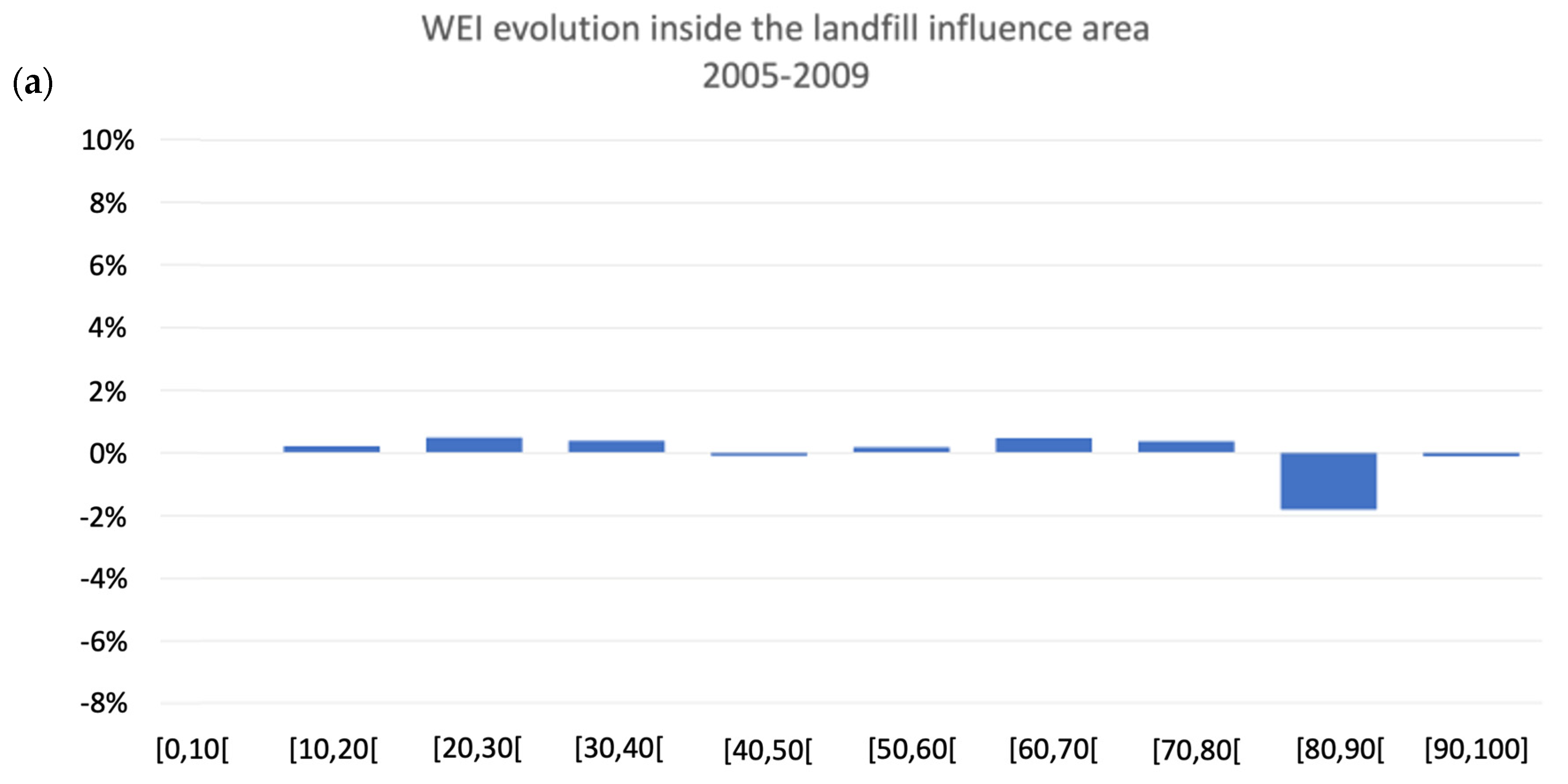
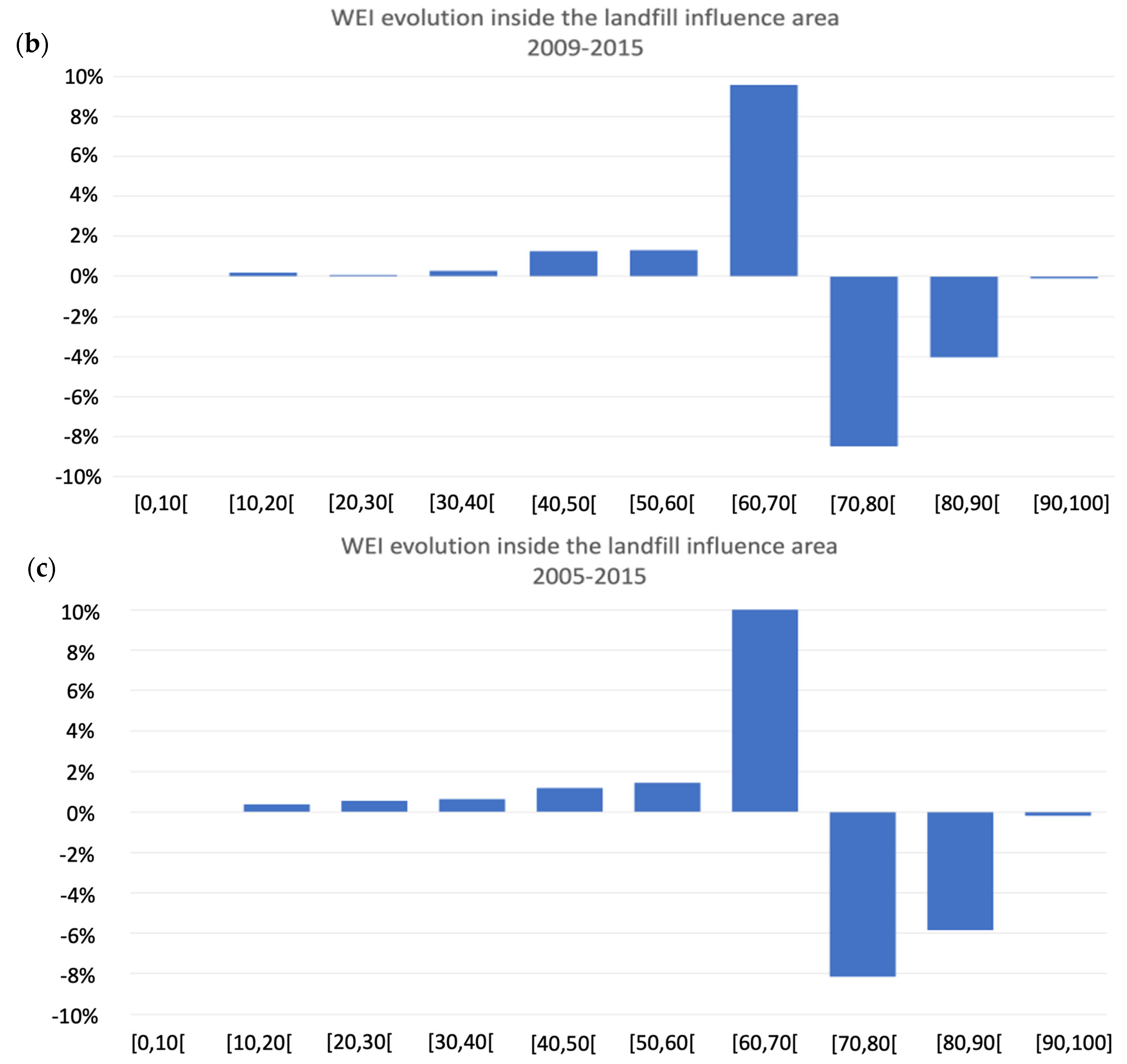
| WEI Range | Environmental Value |
|---|---|
| 0 ≤ WEIk < 40 | Low |
| 40 ≤ WEIk < 70 | Medium |
| 70 ≤ WEIk ≤ 100 | High |
| Management Area | Landfill Name | UTM X | UTM Y | Max. Capacity (m3) |
|---|---|---|---|---|
| C1 | Cervera del Maestre | 781,814 | 4,484,279 | 872,865 |
| C2 | Onda | 735,340 | 4,430,582 | 684,524 |
| C3-V1 | Algimia de Alfara | 720,771 | 4,401,972 | 808,622 |
| V2 | Dos Aguas | 684,001 | 4,350,298 | 5,618,259 |
| V3 | Caudete de las Fuentes | 649,268 | 4,376,935 | 1,997,450 |
| A1 | El Campello | 732,081 | 4,263,098 | 2,412,261 |
| A2 | Xixona | 718,590 | 4,263,442 | 2,577,105 |
| A3 | Villena | 682,001 | 4,279,811 | 1,127,534 |
| A4 | Fontcalent | 709,909 | 4,249,478 | 5,244,391 |
| A5 | Elche | 705,687 | 4,244,084 | 2,500,000 |
| Categories | Area (Has) | % Area | Differences % 2015–2005 | ||
|---|---|---|---|---|---|
| 2005 | 2015 | 2005 | 2015 | ||
| Isolated industrial area | 7.39 | 14.20 | 0.09 | 0.18 | 0.09 |
| Railways | 5.52 | 5.52 | 0.07 | 0.07 | 0.00 |
| Road Networks | 41.72 | 41.72 | 0.53 | 0.53 | 0.00 |
| Urban discontinuous | 1.17 | 0.01 | 0.01 | ||
| Irrigated herbaceous crops | 4.71 | 0.06 | −0.06 | ||
| Non-Irrigated herbaceous crops | 0.96 | 0.96 | 0.01 | 0.01 | 0.00 |
| Citric fruit trees | 589.84 | 591,68 | 7.51 | 7.53 | 0.02 |
| Non-Citric fruit trees | 44.57 | 75.73 | 0.57 | 0.96 | 0.40 |
| Non-predefined mosaic | 2977.93 | 3370.53 | 37.92 | 42.92 | 5.00 |
| Olives | 65.05 | 23.13 | 0.83 | 0.29 | −0.53 |
| Pastures | 879.21 | 674.11 | 11.19 | 8.58 | −2.61 |
| Conifers | 518.83 | 321.15 | 6.61 | 4.09 | −2.52 |
| Hardwood evergreen | 2609.07 | 2590.55 | 33.22 | 32.98 | −0.24 |
| Scrub | 91.92 | 91.92 | 1.17 | 1.17 | 0.00 |
| Soil without vegetation | 10.32 | 10.32 | 0.13 | 0.13 | 0.00 |
| Extraction or discharge zones | 6.75 | 1.06 | 0.09 | 0.01 | −0.07 |
| Artificial water surface | 5.87 | 0.07 | 0.07 | ||
| Mining zones | 8.52 | 0.11 | 0.11 | ||
| Burned areas | 25.63 | 0.33 | 0.33 | ||
| TOTAL | 7853.77 | ||||
| WEI Values | WEI Variation | |||||
|---|---|---|---|---|---|---|
| Landfill Name | 2005 | 2009 | 2015 | 2005 | 2009 | 2015 |
| Cervera del Maestre | 71.63 | 71.49 | 71.04 | −0.18% | −0.63% | −0.81% |
| Onda | 69.05 | 68.50 | 67.48 | −0.80% | −1.49% | −2.28% |
| Algimia de Alfara | 79.45 | 79.60 | 79.01 | 0.19% | −0.74% | −0.55% |
| Dos Aguas | 73.31 | 73.35 | 65.54 | 0.06% | −10.65% | −10.59% |
| Caudete de las Fuentes | 74.21 | 73.82 | 73.06 | −0.52% | −1.03% | −1.55% |
| El Campello | 77.71 | 76.61 | 76.46 | −1.42% | −0.19% | −1.61% |
| Xixona | 76.86 | 74.70 | 72.81 | −2.81% | −2.53% | −5.27% |
| Villena | 69.15 | 68.24 | 68.08 | −1.32% | −0.23% | −1.54% |
| Fontcalent | 66.91 | 66.21 | 65.26 | −1.05% | −1.42% | −2.46% |
| Elche | 70.69 | 69.76 | 69.16 | −1.31% | −0.87% | −2.17% |
| Average | 72.90 | 72.23 | 70.79 | −0.92% | −1.99% | −2.89% |
Publisher’s Note: MDPI stays neutral with regard to jurisdictional claims in published maps and institutional affiliations. |
© 2022 by the authors. Licensee MDPI, Basel, Switzerland. This article is an open access article distributed under the terms and conditions of the Creative Commons Attribution (CC BY) license (https://creativecommons.org/licenses/by/4.0/).
Share and Cite
Rodrigo-Ilarri, J.; Rodrigo-Clavero, M.-E.; Romero, C.P.; Suárez-Romero, P. Do Solid Waste Landfills Really Affect Land Use Change? Answers Using the Weighted Environmental Index (WEI). Remote Sens. 2022, 14, 5502. https://doi.org/10.3390/rs14215502
Rodrigo-Ilarri J, Rodrigo-Clavero M-E, Romero CP, Suárez-Romero P. Do Solid Waste Landfills Really Affect Land Use Change? Answers Using the Weighted Environmental Index (WEI). Remote Sensing. 2022; 14(21):5502. https://doi.org/10.3390/rs14215502
Chicago/Turabian StyleRodrigo-Ilarri, Javier, María-Elena Rodrigo-Clavero, Claudia P. Romero, and Patricio Suárez-Romero. 2022. "Do Solid Waste Landfills Really Affect Land Use Change? Answers Using the Weighted Environmental Index (WEI)" Remote Sensing 14, no. 21: 5502. https://doi.org/10.3390/rs14215502
APA StyleRodrigo-Ilarri, J., Rodrigo-Clavero, M.-E., Romero, C. P., & Suárez-Romero, P. (2022). Do Solid Waste Landfills Really Affect Land Use Change? Answers Using the Weighted Environmental Index (WEI). Remote Sensing, 14(21), 5502. https://doi.org/10.3390/rs14215502








